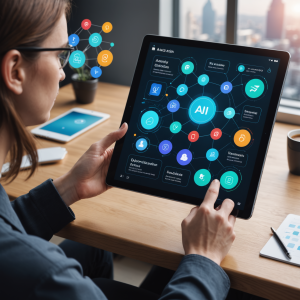As the landscape of productivity shifts, AI assistants are quickly becoming essential allies in our daily routines. These digital companions don’t just streamline tasks; they also help us reclaim valuable time to focus on what truly matters. What can you expect to learn about these innovative tools?
What You Will Learn
- AI assistants leverage technologies like machine learning and natural language processing to perform tasks effectively.
- They can automate repetitive tasks, manage schedules, and provide personalized suggestions based on user behavior.
- Understanding your specific needs is crucial when choosing the right AI assistant to enhance productivity.
- Ethical considerations, including data privacy and transparency, are key to responsible AI assistant usage.
Understanding AI Assistants: The Future of Productivity
As we dive into the realm of AI assistants, it’s fascinating to consider how these technologies are reshaping the way we work and live. AI assistants are not just tools; they’re becoming integral to our productivity. They help us manage tasks, schedule meetings, and even answer questions, allowing us to focus on what truly matters.
But how do these AI assistants work? They leverage machine learning, natural language processing, and data analytics to perform tasks and provide information. This combination of technologies ensures that they can understand and respond to our needs effectively, making them invaluable in our daily routines!
What Are AI Assistants and How Do They Work?
AI assistants are software applications that utilize artificial intelligence to assist users with various tasks. They can recognize voice commands, understand context, and gather information from vast data sources. This functionality allows them to provide personalized suggestions and automate repetitive tasks. For further insights into how artificial intelligence is being implemented across government initiatives, you can explore resources from CIO.gov’s AI in Action.
- Voice Recognition: AI assistants can understand spoken language, making it easy to interact with them hands-free.
- Task Automation: They can schedule events, send reminders, and even control smart home devices.
- Data Analysis: AI assistants analyze user behavior and preferences to offer tailored recommendations.
By continuously learning from user interactions, AI assistants improve their responses over time. This adaptability makes them more effective in meeting our unique needs, ultimately boosting our productivity!
The Evolution of AI Assistants: A Brief Overview
The journey of AI assistants began decades ago, with early systems focused on basic command-response functions. However, with advancements in AI technology, these assistants have transformed into sophisticated tools capable of complex interactions. For a broader understanding of how AI is shaping various sectors, including education, a report from the U.S. Department of Education offers valuable perspectives.
- Early Days: The first AI assistants were rule-based systems, limited in functionality.
- Introduction of Machine Learning: The ability to learn from data marked a significant turning point, enhancing performance.
- Modern AI Assistants: Today’s AI assistants, like Siri and Alexa, offer seamless integration across devices and platforms.
As we look forward, the evolution of AI assistants continues to be exciting. With each upgrade, they become more intuitive and capable, paving the way for a future where productivity is enhanced like never before!
We Want to Hear From You!
As you explore the world of AI assistants, what features do you find most valuable? Share your thoughts below:
Summarizing the Impact of AI Assistants on Productivity
AI assistants have revolutionized the way we approach productivity in both personal and professional settings. By automating mundane tasks, these intelligent tools allow us to focus on higher-value activities. As we evaluate their impact, it’s essential to consider how they can be tailored to meet individual and organizational needs.
In selecting the right AI assistant, keep in mind several factors that can significantly enhance your productivity. Whether you require automation for repetitive tasks or personalized assistance, understanding your requirements is crucial for optimal outcomes.
Key Takeaways: Choosing the Right AI Assistant for Your Needs
- Identify specific tasks you want to automate or simplify with an AI assistant.
- Evaluate the integration capabilities of the assistant with your existing tools.
- Consider privacy features and the level of customization available.
- Look for user-friendly interfaces that facilitate easy onboarding.


